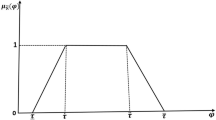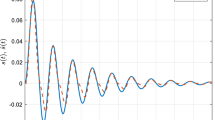Abstract
In this study, an indirect adaptive type-2 bionic fuzzy control method is proposed for a class of nonlinear systems. By regarding the niche of each species in an ecosystem as the antecedent, the fuzzy system with biological characteristics is constructed based on the niche “ecostate-ecorole” theory. In the actual system, we design a fuzzy control system using a type-2 bionic fuzzy system and provide both the adaptive law and constraint conditions of the system parameters. The stability of the closed-loop system is proved with all the state variables uniformly bounded in the Lyapunov sense. Additionally, the convergence of the bionic fuzzy control system is analyzed. Finally, the simulation results obtained for a permanent magnet direct current motor demonstrate the effectiveness and superiority of the designed method.








Similar content being viewed by others
References
Zhao T, Qian BB, Li YM (2013) Type-2 fuzzy control based on biological adaptation strategies. Control Eng China 20(06):1198– 1202
Li L, Qian B, Sun Y (2012) A new direct adaptation fuzzy control which based on type-2 fuzzy. J Syst Sci Math Sci Chin Ser 30(02):236–254
Zhao T, Qing B, Li Y (2015) The fuzzy direct adaptive control based on bionic characteristics. Math Pract Theory 5(16):248–256
Hua J, Yang X, Li Y (2015) The indirect bionic fuzzy adaptive control using estimation for approximation errors. Math Pract Theory 45(09):183–192
Wang H, Wang Z, Liu Y-J, Tong S (2017) Fuzzy tracking adaptive control of discrete-time switched nonlinear systems. Fuzzy Sets Syst 316(1):35–48
Liu Y J, Tong S (2014) Adaptive fuzzy control for a class of nonlinear discrete-time systems with backlash. IEEE Trans Fuzzy Syst 22(5):1359–1365
Liu Y J, Tong S (2015) Adaptive fuzzy identification and control for a class of nonlinear pure-feedback MIMO systems with unknown dead zones. IEEE Trans Fuzzy Syst 23(5):1387–1398
Liu Y J, Tong S, Li D J, Gao Y (2016) Fuzzy adaptive control with state observer for a class of nonlinear discrete-time systems with input constraint. IEEE Trans Fuzzy Syst 24(5):1147– 1158
Chen C L P, Liu Y J, Wen G X (2014) Fuzzy neural network-based adaptive control for a class of uncertain nonlinear stochastic systems. IEEE Trans Cybern 44(5):583–593
Li Y, Hu S, Li L (2004) Fuzzy control method based on niche technique. Syst Eng- Theory Pract 24 (3):63–68
Li Y, Hu S, Hao F (2004) Fuzzy mathematical model of complex ecological system. Fuzzy Syst Math 18(2):89–99
Li Y, Li L (2002) Intelligent control methods of greenhouse system niche. Trans CSAE 6(18):103–106
Li Y, Hu S (2005) Fuzzy adaptive control method with biological world. Int J Model Simul 2(13):81–90
Zhao T (2012) Research of fuzzy control based on biological adaptive strategies. East China Normal University, pp 7–9
Li Y, Du Y (2011) Indirect adaptive fuzzy control on interval type-2 T-S model. Control Theory Appl 28 (11):1558– 1568
Zadeh LA (1975) The concept of a linguistic variable and its application to approximate reasoning. Inf Sci 8:199–249
Mendel J M (2009) On answering the question ‘Where do I start in order to solve a new problem involving interval type-2 fuzzy sets? Inf Sci 179(19):3418–3431
Zhang Q, Wang S, Tan Z (2009) Equivalence between type-2 TSK fuzzy model and uncertain Guassian mixture model. Control Theory Appl 26(2):186–188
Mendel J M (2004) Computing derivatives in interval type-2 fuzzy logic systems. IEEE Trans Fuzzy Syst 12:84–98
Kheireddine C, Lamir S, Mouna G, Khier B (2007) Indirect adaptive interval type-2 fuzzy control for nonlinear systems. Int J Model Identif Control 2(2):106–119
Sun X (2006) The modeling and application of niche and community based on type-2 fuzzy sets. Jiangsu University, pp 1–60
Hisdal H (1981) The IF THEN ELSE statement and interval-valued fuzzy sets of higher type. Int J Man Mach Stud 15:38– 455
Li C (1996) The adaptive fuzzy control of mechatronic plants. South China Univ of Tech, pp 33–72
Chang S-Y, Yu P-H, Su W-C (2013) Pre- and post-filtering approach to sensorless VSS speed control of a permanent magnet DC motor subject to Hammerstein and Wiener nonlinearities. Control Eng Pract 21(11):1577–1583
Acknowledgements
This work was supported by the National Natural Science Foundation of China: bionic intelligent control method of chaotic ecosystems under slow disturbance [grant number 11072090].
Author information
Authors and Affiliations
Corresponding author
Ethics declarations
Competing financial interests
The authors declare that there is no conflict of interest regarding the publication of this paper.
Additional information
Competing financial interests
The authors declare that there is no conflict of interest regarding the publication of this paper.
Rights and permissions
About this article
Cite this article
Zhang, F., Hua, J. & Li, Y. Indirect adaptive type-2 bionic fuzzy control. Appl Intell 48, 541–554 (2018). https://doi.org/10.1007/s10489-017-0991-3
Published:
Issue Date:
DOI: https://doi.org/10.1007/s10489-017-0991-3




